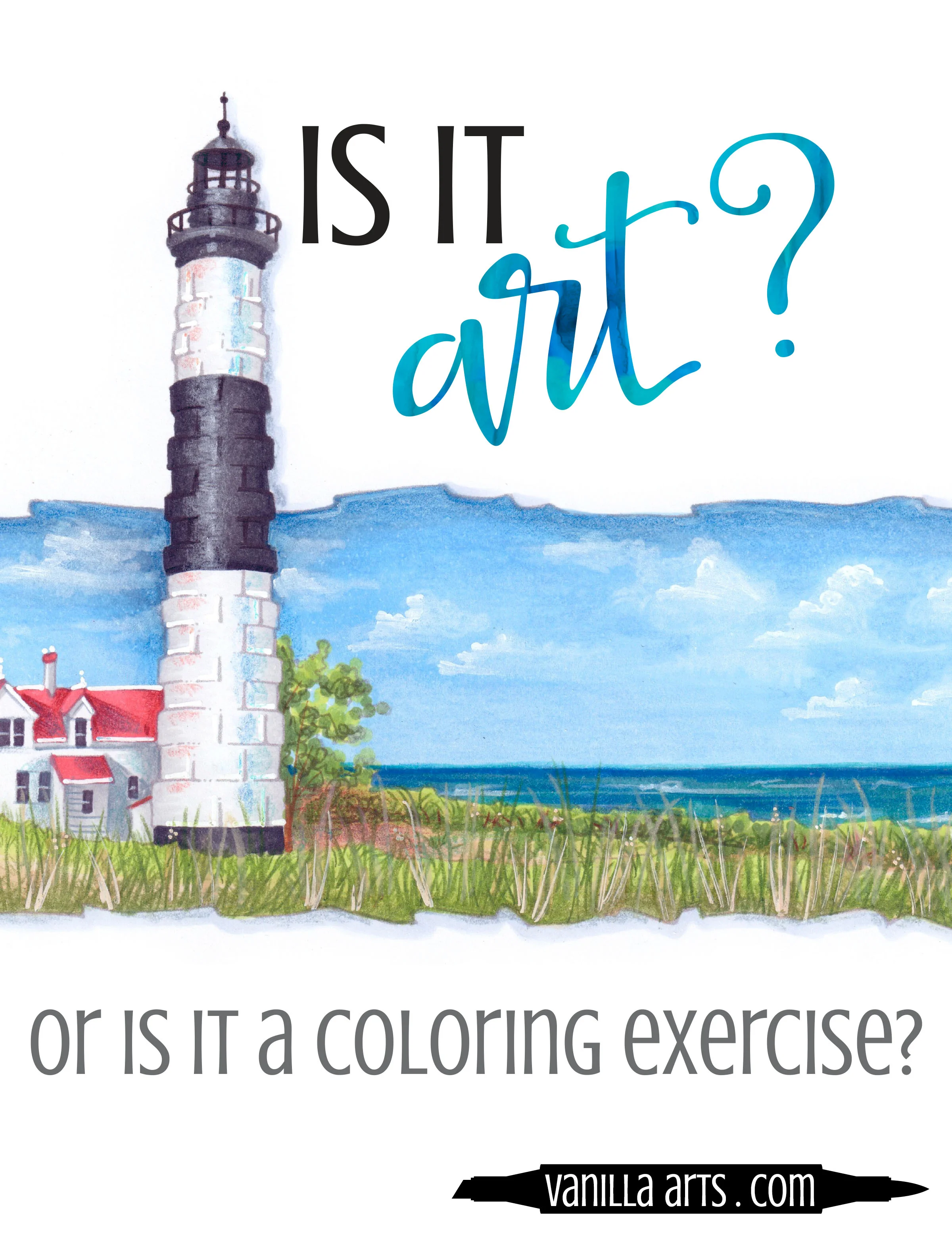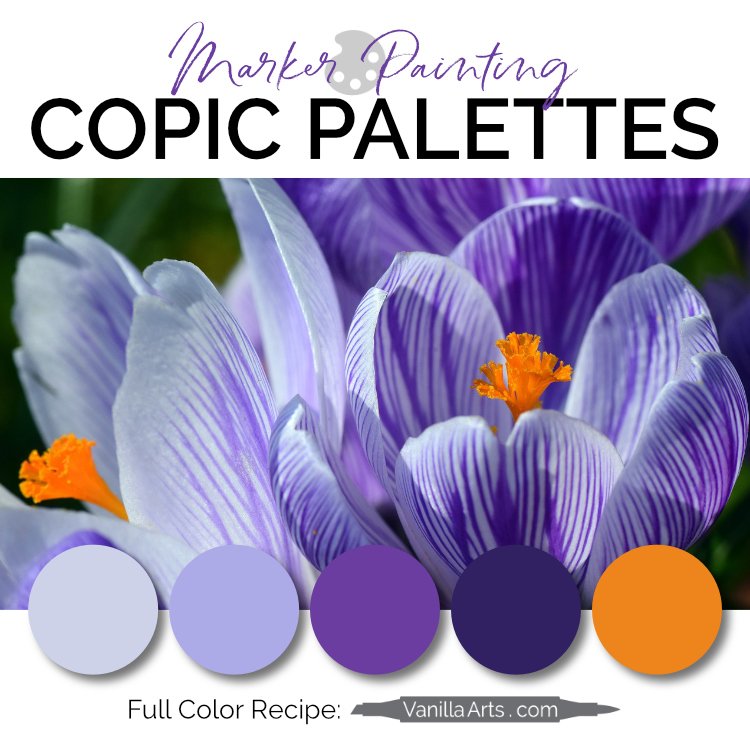Art versus Exercise: Are Copic Tutorial Projects Considered Art?
Your coloring is amazing!
And while I’d love to hog all the credit and boast that I’m an awesome teacher turning randos into Rembrandts…
The truth is, it’s not me, it’s you.
Coloring has reached a new level.
Copic Markers and colored pencils are not just a goofy wine-mom hobby anymore.
People are learning to make art!
There are some really talented people out there who work 9 to 5 jobs as dentists, accountants, and bus drivers. If you’re reading this, you’re likely one of them.
You’re not an artist but you have hidden artistic skills.
Coloring just happens to bring out your long buried, untapped gifts and shines a spotlight on them.
So it’s not me, it’s you.
Yes, Dorothy. You had it all along.
A lot of people who take coloring classes could have gone into art. A lot of good colorers should have gone into art.
But there’s an important divide we don’t often talk about:
When does coloring become art?
What’s the difference between coloring and making art?
And here’s a more important question:
Once you’re extremely good at coloring, how do you push yourself beyond the casual level to start creating art?
For starters, let’s clarify the difference.
Sadly, art is a wishy-washy term which is applied to almost everything nowadays.
Hollywood’s latest box-office bomb, your neighbor’s fancy cupcakes, and the Mona Lisa are all called art.
Really?
To make people feel important, we’ve trashed the meaning of “artist”. It no longer stands for anything concrete.
To paraphrase Mr. Incredible: If everyone is an artist, then no one is an artist.
So let’s honestly acknowledge that there’s a difference between making cool stuff and making art.
I know it’s a controversial thing to say and it’ll annoy a lot of people, but if everyone gets a trophy for coloring, then there’s no value to the contents of any art museum.
Call me judgmental, I’m fine with that. I see nothing wrong with valuing a Picasso masterpiece over the cat I sketched yesterday in my sketchbook.
We can be artistic without actually making art, okay?
Now I’m going to say something else that’s controversial:
There’s a big difference between coloring a class project and making art.
Is it art or an exercise?
You wouldn't call the third jazzercise lady from the left a dancer, would you?
Sure, she’s dancing… kind’a.
There is a difference between dancing and being a dancer.
You can do the same motions a dancer does but it doesn’t make you Lord of the Dance.
Art is the same way. You can go through all the artist motions but you won’t be solo-showing at the Guggenheim anytime soon.
This is important to keep in mind when you post your class projects to Facebook or Instagram. Especially when friends and relatives gush back, “Wow, you’re such a wonderful artist!”
Your online circle doesn’t understand that what you’ve posted is the equivalent of taking a selfie in Zumba class.
Don’t let the “You’re so talented!” go to your head.
If you are following along with a teacher and copying everything they do, then you’re going through the motions of making art without actually making art.
For some, that’s all you want to do. You only want to color and have fun doing it.
Don't get me wrong, I have no problem with recreational coloring! Coloring classes are an excellent way to keep your hands busy and your mind nimble!
But a lot of you want to take the next step and move beyond art exercises.
And you’re feeling paralyzed because coloring classes aren’t set up to teach you anything beyond exercises.
So Iet’s talk about the first step:
How do we begin to create art?
This is head-smack simple and hardly the subject for an expansive blog post but I’ll bet you don't hear about it in many coloring classes.
FIRST RULE TO MAKING ART: Stop copying
In art, there’s something we call a “voice”. The way to begin moving from coloring exercises to artistic expression is to begin adding little bits of your voice to your coloring.
If you’re coloring something exactly the same way someone else did— whether it’s a teacher, a project off the internet, or even the colored sample on the stamp package… Any time you try to match someone else, you are not making art, you are copying.
You are not expressing yourself, you are mimicking someone else’s voice.
Even though you physically colored it, there’s no you in a copied project.
The first step to artistry is to add your voice to everything you color.
Now I’m not recommending that you chop off your left ear and add it to Aunt Polly’s next handmade birthday card.
Art doesn’t have to be extreme.
I’m simply asking you to add one unique element to your next coloring project.
use a different marker palette
add a pattern or texture that isn’t on the original stamp or sample project
mask off part of the stamp to focus on the most interesting object
change the object (make a grizzly bear into a panda)
combine several stamps into a new composition
When you deviate from the sample project, you’re injecting unique personality into the image. That’s adding voice. You are using something old to create something new by adding a little bit of yourself.
You don’t have to redesign the whole thing. Baby steps are better.
Don’t pressure yourself into turning a Easter Rabbit stamp into a Volkswagen Beetle. Just change one small thing every time you color a stamp.
Artistic baby steps add up
Once you’re confident about using your own color palettes or unique textures, you’ll want to change more and more.
A small artistic “more” leads to more mores.
It’s a gradual process.
As you break-free from the confines of tutorials and sample projects, you will naturally add your own voice to your coloring. Over time, you'll develop a look or a style that’s 100% you.
Adding you to your images begins the process of artistic self-expression.
They don’t let you do your own Zumba routine in class but it’s totally okay to do it in coloring.
End the copy-catting is the first step to becoming an artist. It’s not the only step but it’s the first and possibly the hardest step.
Letting go of the guardrail is difficult but worth it.
It doesn’t matter how well you color a project. You can be the most amazing student on the face of the planet, but if your project looks exactly like the class sample, you haven’t done anything more than go through the motions of artistry.
Artists invent their own motions.
Stop being the third Zumba girl from the left. Add a small bit of your voice to your next coloring project.
That’s the first step to becoming an artist.
Big Sable Point
Join me for a fun Copic Marker + Colored Pencil lesson in the Vanilla Workshop
Big Sable Point was recorded live, now it’s a Marker Painting Workshop!
Edited classes with perfect narration tend to make the coloring process look faster, easier, and smoother than it really is.
Stop comparing yourself to the supermodel version of an artist!
Real time coloring with real mistakes and real fixes.
Class Printable Pack Includes:
Class syllabus with detailed recipe guide
Full color project sample
Guide to Copic base
Detailed color map
Project inspiration references
Select Supplies used in “Big Sable Point”
(Contains affiliate links to Amazon and Dick Blick. Complete, printable supply list available with class purchase.)



















